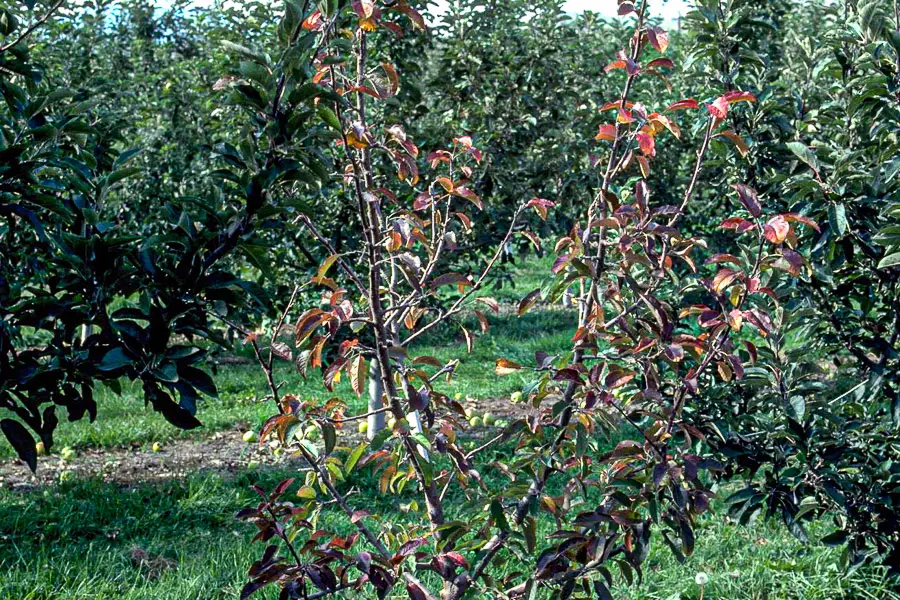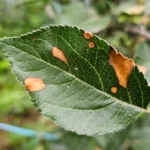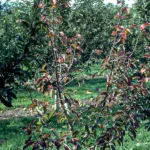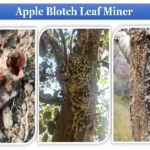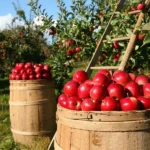Root Rot
Apple trees are iconic symbols of orchards and gardens, cherished for their delicious fruits and beautiful blooms. However, these trees are not immune to diseases, and one common ailment that can significantly impact their health and productivity is root rot. Root rot is a fungal disease that affects the roots of apple trees, leading to decay, reduced vigour, and even death. In this comprehensive article, we will delve into the causes and factors contributing to root rot, explore its symptoms and signs of infection, discuss preventive measures to minimize the risk, and provide management strategies to control and mitigate the disease’s impact on apple trees. Click to know more about Kiwi Cultivation in Kashmir
Root rot is a general term used to describe a condition where the roots of a plant decay due to infection by various types of fungi. In the case of apple trees, several fungal pathogens, such as Phytophthora, Armillaria, and Pythium, can cause root rot.
Causes of Root Rot in Apple Trees:
The development and progression of root-rot in apple trees are influenced by multiple factors, including:
Fungal pathogens:
Various species of fungi thrive in moist, poorly drained soil conditions, leading to root infections and subsequent rot.
Environmental conditions:
Excessive rainfall, overwatering, and poor soil drainage create an ideal environment for fungal growth and root rot.
Soil compaction:
Compacted soils restrict the movement of air and water, promoting anaerobic conditions that favor fungal pathogens and inhibit root health.
Poor soil quality:
Soil lacking in organic matter and nutrients can weaken the tree’s immune system, making it more susceptible to diseases like root rot.
Tree stress:
Stressed apple trees, whether due to improper care, physical damage, or other diseases, are more vulnerable to root rot infections.
Identifying Root Rot in Apple Trees
Timely identification of root rot symptoms is crucial for effective management. Here are the key signs to look for:
Foliage Symptoms:
Leaf wilting: Affected trees exhibit wilting leaves, which may turn yellow or brown before eventually falling off.
Stunted growth: Apple trees suffering from root rot often show limited growth, with stunted branches and reduced overall vigor.
Leaf discoloration: Leaves may turn yellow, appear scorched, or exhibit an unhealthy, dull green color.
Root Symptoms:
Root discoloration: When examining the root system, brown or black discoloration can be observed. The roots may appear mushy, slimy, and exhibit signs of decay.
Lack of fibrous roots: A healthy root system should have numerous white, fibrous roots. Root rot causes these roots to diminish in number and size.
Smell: An unpleasant odor, often described as musty or sour, may emanate from the root system of affected trees.
Other Symptoms of Root Rot:
Cankers and lesions: Bark cankers or lesions may develop near the base of the tree, indicating the spread of the fungal infection.
Preventing Root Rot
Prevention is the best approach when it comes to managing root rot in apple trees. Implementing the following preventive measures can help protect your trees from the disease:
Site Selection:
Choose well-drained locations: Select areas with soil that provides good drainage, avoiding spots prone to waterlogging.
Consider soil pH: Apple trees prefer slightly acidic to neutral soil (pH 6.0-7.0). Test the soil and amend it if necessary.
Proper Irrigation:
Watering practices: Water apple trees deeply but infrequently, allowing the soil to dry out between waterings. Avoid overwatering, which can lead to waterlogged conditions.
Irrigation system management: Ensure irrigation systems are properly calibrated to provide adequate moisture without saturating the soil.
Soil Improvement:
Organic matter addition: Incorporate organic matter, such as compost or well-rotted manure, into the soil before planting to improve its structure and drainage.
Mulching: Apply a layer of organic mulch around the base of the tree to conserve moisture, moderate soil temperature, and suppress weed growth.
Disease-Free Stock:
Source healthy trees: Start with disease-resistant apple tree varieties from reputable nurseries or certified sources.
Inspect roots before planting: Check the root system of new trees for any signs of discoloration or rot before planting.
Sanitation Practices:
Remove infected plant material: Regularly remove and destroy fallen leaves, branches, and other infected debris to prevent the spread of fungal spores.
Managing Root Rot
If root rot is already present in your apple trees, employing appropriate management strategies can help minimize its impact and save your trees:
Fungicide Application:
Consult experts: Seek advice from local agricultural extension services or horticulturists to identify and select fungicides effective against root rot pathogens.
Timing: Apply fungicides as a preventive measure or during the early stages of infection to limit the spread of the disease.
Follow instructions: Adhere to the label instructions regarding application rates, timing, and safety precautions.
Root Pruning and Rehabilitation:
Root pruning: Severely affected trees may benefit from root pruning to remove infected portions and stimulate the growth of healthy roots. Prune during the dormant season to minimize stress on the tree.
Rehabilitation measures: Implement tree care practices that promote overall tree health, such as proper nutrition, watering, and protection against pests and diseases.
Improve Drainage:
Drainage system installation: Install drainage tiles or consider constructing raised beds to improve soil drainage and prevent waterlogging.
Soil amendment: Incorporate organic matter and coarse sand into the soil to enhance its structure and promote better water movement.
Soil Solarization:
Solarization process: In severe cases, solarization can be employed to kill off fungal pathogens in the soil. Cover the affected area with clear plastic during the hottest months of the year to raise soil temperatures and kill the pathogens.
Tree Removal:
Last resort: If the disease has extensively damaged the tree and its chances of recovery are minimal, removing and properly disposing of the affected tree is necessary to prevent further spread of the disease.
Conclusion
Root rot can significantly impact the health and productivity of apple trees. Understanding the causes, recognizing the symptoms, and implementing preventive measures are crucial for managing this destructive disease. By selecting suitable sites, practicing proper irrigation, improving soil drainage, and implementing good sanitation practices, apple tree owners can reduce the risk of root rot. Additionally, timely application of fungicides, root pruning, and rehabilitation efforts can help mitigate the impact of the disease. Remember that a healthy root system is essential for the overall health and success of apple trees. By taking proactive measures, you can ensure that your apple trees thrive and continue to provide you with delicious fruits for years to come.
Author: Dr. Syed Sami Ullah, Ph.D., Fruit Science, Founder Temperate Farming

